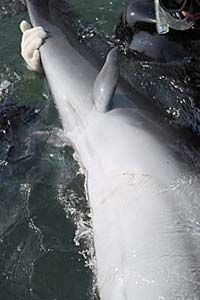Every once in awhile, an unsuspecting scientist will come across an animal with a very strange trait -- like a whale with legs. That's right, a whale with legs. Obviously, most whales don't have legs. So how did this happen?
Our mammal friend the whale gives us the perfect example of an atavism, a trait from a distant evolutionary ancestor that has reappeared in a modern-day organism. Millions and millions of years ago, the ancestors of whales walked on land. Over time, they went from land dwellers to sea creatures, possibly in search of food, and lost the legs and other traits they wouldn't need in the ocean. To understand how this happened, let's talk a little bit about how evolution works.
Advertisement
The theory of evolution posits that DNA can change. These changes in an organism's DNA can be good, bad or neutral. Over time, these changes, or mutations, lead to new species. Natural selection is part of evolution. The organisms with good mutations -- beneficial changes -- thrive and reproduce, while those with bad mutations die out. Natural selection chooses the pick of the litter every time. (For a more in-depth explanation, see How Evolution Works). The whales that took to the sea no longer benefited from legs, so their DNA mutated to get rid of this trait. The whale ancestors whose bodies adapted best to their environment thrived and passed these adaptations down to their offspring.
Dollo's law states that evolution isn't reversible, and that things that have been lost during the course of evolution don't reappear. Once it's gone, it's gone -- sayonara, whale legs. Later scientists modified the law to say that the probability of this happening is low. But what if Dollo's law is wrong? A whale with legs is just one example of an atavism - they crop up more frequently than you would suppose. Maybe evolution works differently from what we had supposed. Maybe understanding atavisms will help us unlock some of the mysteries of evolution, a theory that still has some holes.
Atavisms have been misunderstood for a long time, partly because of a man named Cesare Lombroso, a social Darwinist who believed that criminals are throwbacks to a primitive human ancestor. He declared that criminals are born criminals, and you can recognize them by their physiology. According to Lombroso, certain facial characteristics denote a criminal. (Interestingly, Lombroso also thought that criminals must have a higher pain threshold than the average citizen because many of them have tattoos from prison. His (faulty) logic was that since criminals have tattoos, and tattoos are painful, then they must have a higher tolerance for pain.) Lombroso's erroneous ideas persisted in some fashion despite evidence that his conclusions weren't scientific at all. People still sometimes associate atavisms with distasteful stereotypes, even though that isn't what the word means.
So what does it mean? Next, we'll look at traits that people mistakenly think are atavisms and how they might happen.
Advertisement

